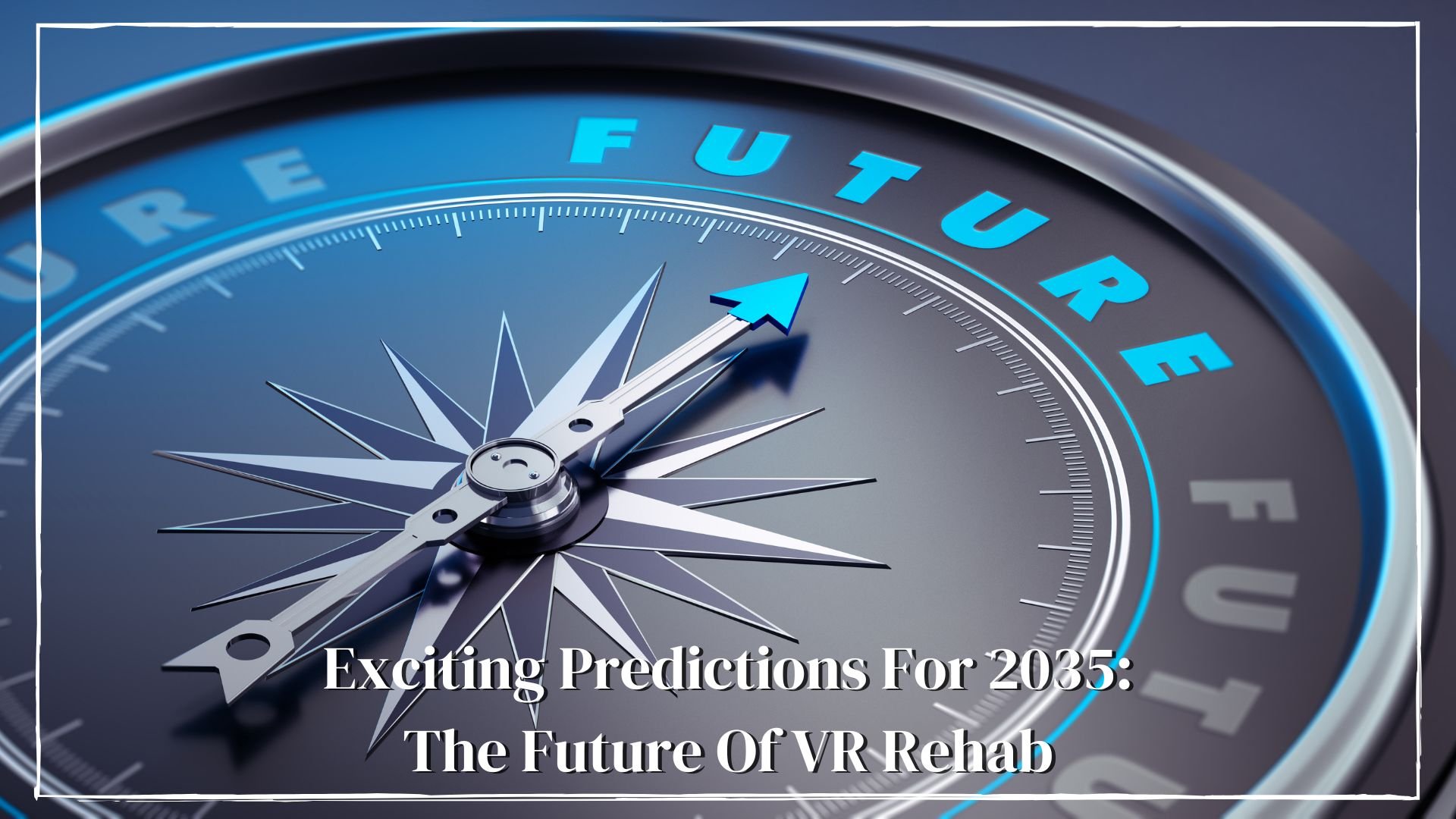Exciting Predictions For 2035: The Future Of VR Rehab
Written by: Brianna Hodge
Virtual reality (VR) rehabilitation has come a long way in the past decade, evolving from a niche technology into a powerful therapeutic tool with the potential to reshape the entire field of neurorehabilitation. If you’ve been following the rise of VR in healthcare, you’ve probably seen how it’s already making waves—enhancing patient engagement, improving outcomes, and reducing clinician burnout. But where do we go from here? What will VR rehab look like in ten years?
Let’s dive into the most exciting predictions for the next decade, backed by real-life case studies and emerging research. Whether you’re a clinician, researcher, or simply interested in cutting-edge rehab tech, this is what you can expect in the near future.
1. AI-Powered Personalization: Smarter, Adaptive Therapy
One of the biggest challenges in rehabilitation is that no two patients are the same. Even if two people suffer a stroke, their recovery paths can be drastically different. This is where artificial intelligence (AI) will take VR rehab to the next level.
Current Trends and Research
A study in 2023 reviewed the effectiveness of VR in stroke rehabilitation and found that personalization is key to better outcomes. Right now, most VR therapy programs rely on pre-set difficulty levels, requiring therapists to manually adjust them based on a patient’s progress. However, AI-driven VR systems will change that by analyzing real-time patient performance and adjusting difficulty dynamically. (Aderinto, Nicholas, et al)
Future Predictions
Imagine a VR system that knows when a patient is struggling or excelling, adapting on the fly to provide the right level of challenge. AI could analyze biometrics—like heart rate, movement patterns, and even eye tracking—to detect fatigue or frustration. This means patients will get therapy that’s neither too easy nor too hard, keeping them motivated and engaged.
2. Expanded Accessibility: Home-Based VR Rehabilitation
The Shift to Remote Rehab
COVID-19 accelerated the shift toward telemedicine, and VR-based rehab is next in line. Studies show that home-based VR rehab can be just as effective as in-clinic therapy. A 2024 study published on Medrxiv found that stroke patients who used VR exercises at home had similar recovery rates compared to those in traditional in-person therapy (Fisk, Aidan, et al.)
Why This Matters
For patients in rural or underserved areas, access to quality rehabilitation can be limited. Travel costs, long wait times, and mobility issues make in-person visits a challenge. Home-based VR solutions will allow patients to receive high-quality therapy without leaving their homes, all while being monitored remotely by their clinicians.
Future Innovations
Within the next decade, VR rehab systems will likely be equipped with AI-powered progress tracking, allowing therapists to monitor compliance and improvement remotely. Expect more insurance providers to cover home-based VR rehab, making it a mainstream option rather than an alternative.
3. Neuroplasticity-Optimized Therapy: Enhancing Brain Rewiring
One of the most exciting aspects of VR rehab is its ability to harness the power of neuroplasticity—the brain’s ability to rewire itself after injury. The next decade will see even more advancements in VR programs designed to optimize neuroplastic changes.
Case Study: Phantom Limb Pain and VR
A groundbreaking case study on “Virtual Reality Intervention for the Treatment of Phantom Limb Pain”, demonstrated how VR can help patients with phantom limb pain by tricking the brain into "seeing" a missing limb move, reducing pain dramatically (Rutledge, Thomas, et al.). This is just one example of how VR can reshape neural pathways, and we can expect much more innovation in this area.
Emerging Research
Recent studies show that VR-based mirror therapy can improve outcomes in stroke survivors by activating brain areas responsible for movement and sensation (Gdiom Gebreheat, et al.). Over the next decade, VR systems will integrate even more neuroscience-based strategies to enhance recovery.
4. Integration of Haptic Feedback: The Sense of Touch in VR Therapy
Right now, most VR rehab programs focus on visual and auditory stimuli, but what about touch? The next decade will bring major advancements in haptic feedback, allowing patients to "feel" virtual objects.
Why Haptics Matter
For patients recovering from spinal cord injuries or strokes, regaining a sense of touch is just as important as regaining movement. Companies like HaptX and Manus are already developing gloves that provide realistic force feedback, and integrating this technology into VR rehab will be a game-changer.
Future Applications
Stroke patients regaining fine motor control by feeling textures and resistance in VR.
Amputees using haptic feedback to experience prosthetic training in a virtual environment.
Parkinson’s patients improving hand stability by manipulating VR objects with force feedback.
5. VR Rehab for Mental Health and PTSD Recovery
VR rehab isn’t just about physical therapy—it’s also becoming a vital tool for mental health treatment, especially for patients with PTSD, anxiety, and depression.
Case Study: VR for PTSD
The Veterans Affairs (VA) system has already adopted VR exposure therapy to help veterans with PTSD confront traumatic memories in a controlled environment. A study on “ Virtual Reality Exposure for Treating PTSD “ found that VR-based exposure therapy significantly reduced PTSD symptoms in veterans compared to traditional talk therapy. (Loucks, Laura, et al. )
What’s Next?
Over the next decade, expect more VR programs designed to help patients with neurological conditions manage anxiety, depression, and stress. AI-driven emotional recognition may also become a standard feature, allowing VR systems to adapt to a user’s emotional state in real time.
6. Neuro Rehab VR: Leading the Smart Rehab Revolution
No discussion about the future of VR rehab would be complete without talking about Neuro Rehab VR, a leader in smart rehabilitation solutions. By combining AI, immersive VR therapy, and clinical insights, Neuro Rehab VR is already shaping what the next decade of rehabilitation will look like.
How Neuro Rehab VR Stands Out
Smart Therapy™ Complete Solution – Gamified, personalized therapy that adapts to each patient’s needs.
AI-Driven Automation – Streamlining clinician workflows, reducing burnout.
Scalability – Used in hospitals, outpatient clinics, and home-based rehab programs.
Future of Neuro Rehab VR
With ongoing innovation, Neuro Rehab VR is set to push boundaries even further—expect advancements in machine learning for smarter therapy adaptations, improved haptic integration, and expanded home-based VR rehab solutions.
7. The Future of VR Rehab Regulation and Insurance Coverage
Right now, one of the biggest hurdles in VR rehab is insurance reimbursement. While Medicare and private insurers are slowly beginning to recognize the benefits of VR therapy, widespread coverage is still a work in progress.
Predictions for the Next Decade
More insurance companies will cover VR-based rehab, especially for stroke, Parkinson’s, and PTSD.
Standardized regulations will emerge to ensure quality control in VR therapy programs.
Hospitals and clinics will invest heavily in VR infrastructure, making it a core part of rehabilitation.
Final Thoughts: A Decade of Transformation Awaits
Looking ahead, the next decade of VR rehabilitation is set to revolutionize how we approach recovery. From AI-driven personalization to home-based rehab, neuroplasticity-optimized therapy, and haptic feedback integration, VR will continue breaking barriers in rehabilitation.
For clinicians, this means better tools to engage patients and reduce burnout. For patients, it means more accessible, effective, and personalized therapy options. And for pioneers like Neuro Rehab VR, it means leading the charge toward a future where smart rehab is the new standard.
-
Aderinto, Nicholas, et al. “Exploring the Efficacy of Virtual Reality-Based Rehabilitation in Stroke: A Narrative Review of Current Evidence.” Annals of Medicine, vol. 55, no. 2, 27 Nov. 2023, https://doi.org/10.1080/07853890.2023.2285907.
Fisk, Aidan, et al. “A Low-Cost Virtual Reality Stroke Rehabilitation System: Breaking down Barriers to Treatment.” Medrxiv., 2024, www.medrxiv.org/content/10.1101/2024.08.23.24312233v2.full-text.
Gdiom Gebreheat, et al. “Application of Immersive Virtual Reality Mirror Therapy for Upper Limb Rehabilitation after Stroke: A Scoping Review.” Neurological Sciences, 29 Apr. 2024, https://doi.org/10.1007/s10072-024-07543-3. Accessed 9 June 2024.
Loucks, Laura, et al. “Virtual Reality Exposure for Treating PTSD due to Military Sexual Trauma.” Journal of Clinical Psychology, 11 Nov. 2024, https://doi.org/10.1002/jclp.23750. Accessed 11 Dec. 2024.
Rutledge, Thomas, et al. “A Virtual Reality Intervention for the Treatment of Phantom Limb Pain: Development and Feasibility Results.” Pain Medicine, vol. 20, no. 10, 5 June 2019, pp. 2051–2059, academic.oup.com/painmedicine/article/20/10/2051/5511535, https://doi.org/10.1093/pm/pnz121. Accessed 27 Jan. 2020.





